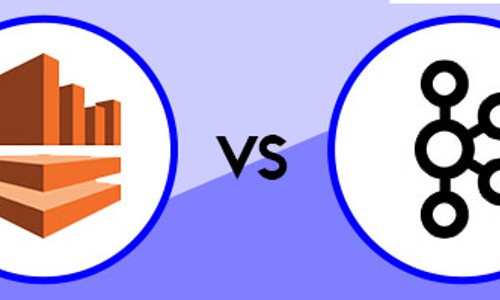The key differences between Amazon Kinesis and Kafka are:
- Data retention: There's a maximum 7-day retention period on Kinesis.
- Set-up: Kafka takes longer to set up than Kinesis. You'll need a team to install (and manage) data clusters.
- SDK support: Kafka supports Java; Kinesis (via AWS) supports Java, Go, Android, and .NET.
- Price: Kafka is open-source and free. Kinesis has no set-up cost; users pay for resources used.
- Reviews: Kafka has a higher customer review score than Kinesis on the website G2 (4.4/5 vs. 4.1/5).
Introducing data streamers! These services validate and route messages from one application to another, managing workload and message queues effectively. The result? Users process messages through a centralized processor and handle large data streams more efficiently.
Amazon Kinesis and Apache Kafka are two data stream services. Originally built as distributed logs, Kinesis and Kafka track log events and process complex data streams in real-time. But which one of these tools provides the most value?
We've compared Amazon Kinesis vs. Kafka in this review, which includes features, prices, and customer review scores.
What is Kinesis?
Amazon Kinesis is a real-time data streaming service that captures data from various sources, including operating logs, social media feeds, website clickstreams, financial transactions, and more. Kinesis then processes and transforms this data and loads it into a data store for analytics. Netflix, for example, uses Kinesis to process billions of traffic flows.
Kinesis is part of Amazon Web Services (AWS). According to Amazon, Kinesis continuously captures gigabytes of data every single second. Users transfer these data streams to AWS data stores.
Integrate.io makes it simple to integrate with Kinesis. Now you can process data with no code. Learn more.
What is Kafka?
Apache Kafka is an open-source "event streaming platform" — a platform that writes and reads event streams. Kafka handles data streams in real-time (like Kinesis.) It’s used to read, store, and analyze streaming data and provides organizations with valuable data insights. Uber, for example, uses Kafka for business metrics related to ridesharing trips.
The big difference between Kinesis and Kafka lies in the architecture. Kafka "decouples" applications that produce streaming data (called “producers”) in the platform’s data store from applications that consume streaming data (called “consumers”) in the platform’s data store. Kafka has more of a scattered nature than Kinesis, making it useful for node failures.
According to Apache, over 80 percent of Fortune 100 companies use (and trust) Kafka.
Amazon Kinesis vs. Kafka Features
|
Kinesis |
Kafka |
|
|
Customer review scores on G2.com |
4.1/5 |
4.4/5 |
|
Where is data stored? |
Kinesis Shard |
Kafka Partition |
|
Support for SDK? |
Java, Android, .NET, Go |
Java |
|
Data retention period |
7 days |
Longer (Users configure retention periods) |
|
Skill level required |
Basic |
Advanced |
|
Customization |
Yes |
Yes |
|
Performance limitations |
Write synchronously to 3 machines at a time |
Fewer limitations |
|
Store |
Dynamo db |
Zookeeper |
|
Price |
Based on resources used, with no upfront costs |
Free (open-source) but consider hardware/set-up costs |
|
Support |
Developer center, tutorials, and more |
Tutorials, meetups, videos, and more |
Kinesis and Kafka have several unique features.
- Kinesis supports Java, Android, .NET, and Go; Kafka only supports Java.
- Kinesis lets users write synchronously to three machines or data centers; Kafka users have more configurations.
- Kinesis stores data in shards; Kafka stores data in partitions
Regarding performance, Kinesis reaches a throughput of thousands of messages every second. Kafka, however, reaches a throughput of around 30,000 messages every second, making it the clear winner.
There are limitations to both platforms. Kinesis has a 7-day data retention period. Kafka takes a lot of effort to set-up and run. (Kafka requires distributed engineering and cluster management experience.)
There is an alternative to both platforms. Integrate.io is a cloud-based ETL/ELT tool that manages complex data pipelines. As a data integration alternative, Integrate.io requires no code and comes with over 1,000 out-of-the-box integrations for loading data into databases, data warehouses, data lakes, Salesforce, and more.
Support and Training
Kinesis
Kinesis has various support options, but all of it falls under its parent company Amazon. Users can access a developer center, knowledge center, and tutorials for tips and how-tos.
Kinesis ranks 8/10 for support on G2.com.
Kafka
Kafka provides more community options than Kinesis, including summit events and meetups, where users can network and discuss the technology. Other support includes tutorials, videos, and sample projects.
Kafka ranks 7.3/10 for support on G2.com.
Pricing
Kinesis
With Kinesis, pricing increases based on the number of shards required and the size of the data producer transmitting to data streams. There is no upfront cost, and you only pay for the resources used.
Kafka
As an open-source platform, Kafka is free. However, it involves a bigger set-up and maintenance process than Kinesis, so consider additional installation/support costs. You’ll need to manage your own infrastructure and think about hardware costs.
Recommended Reading: How Integrate.io Pricing Works
Conclusion
Kinesis and Kafka are data stream services that streamline complex data streams. Both services are reliable and provide value but also have limitations. If you want to keep messages for over 7 days, Kafka could provide a solution. However, it requires (lots of) human support to make the data stream process work.
Want to extract, transfer, and load data from various sources but lack a data engineering team? Explore the reliability of an ETL solution like Integrate.io. Click here to schedule a demo or 14-day risk-free pilot.










